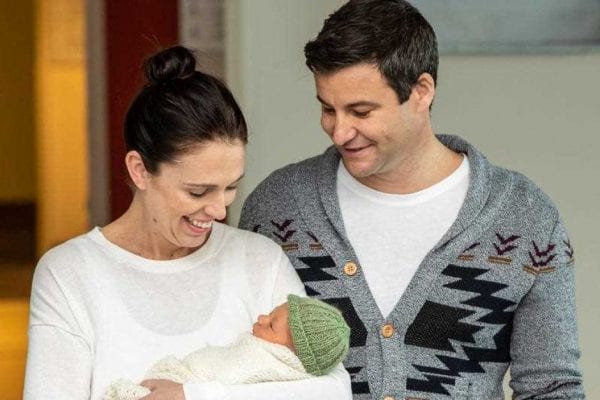The pair emerged from hospital looking much like any other couple in the throes of new parenthood– excited, proud and a touch bleary eyed. The tiny bundle in Ardern’s arms dozed peacefully, prompting her mum to joke she’d ironically been lulled to sleep by the awaiting media circus.
Despite officially being on maternity leave, Ardern graciously took the time to address the crowd assembled and reveal the name of her new daughter: Neve Te Aroha Ardern-Gayford. A name which she said they’d both liked and felt suited their daughter when they met her on Thursday.
‘Te Aroha’, the baby’s middle name however, was one the couple had “settled on quite early,” said Ardern, and the reason was simple.
“Te Aroha was our way of reflecting on the amount of love this baby’s been shown before she even arrived, and all of the names we were gifted along the way,” The PM expressed through visible emotion. “I thought, how do I reflect the generosity–particularly from all of the iwi who gifted us names–and Te Aroha seemed to me to be a way we could show that love and generosity.”
‘Aroha’ touchingly means ‘compassion’ in the country’s native dialect Māori, and the iwi referred to by Ardern are Māori tribes. Te Aroha is also a mountain/region in New Zealand’s North Island close to where members of Ardern’s family still live.
The decision to honour New Zealand’s first people in their baby’s name may seem small, but such a gesture holds huge symbolic meaning. It is also entirely consistent with Jacinda Ardern’s approach to leadership.
In April this year, Ardern turned heads at Buckingham Palace when she arrived wearing a traditional Māori korowai cloak to a state banquet of world leaders including Queen Elizabeth II. The footage went viral with people all over the world praising Ardern’s efforts to celebrate her country’s native history in such a public forum.
Donna Campbell, a Māori weaver told the BBC that Ardern’s gesture had made her “really emotional,” while a lecturer at Waikato University in Hamilton added it was “a real acknowledgment of the prestige and power of a woman.”
“To wear something that is so intrinsically of this place here, and for her to wear it at that event knowing that she would be photographed from every angle, that’s a real acknowledgment of her relationship with the Māori people and with New Zealand.”
Mark Sykes, Te Papa’s guardian of Māori special collections said, “I think it shows how [Ardern] is portraying herself as a leader of Māori, of all of New Zealand, of everyone. It made me feel proud. She wore it well. She wore it so well.”
Indeed, Jacinda Ardern has made a deliberate point in her short tenure to incorporate Māori culture and advice from iwi in her leadership meaningfully. Regular footage can be seen of her speaking with elders, playing with children and visiting traditional sites.
In February this year, Ardern made the somewhat controversial decision to attend the commemorative ceremony at Waitangi on New Zealand’s national day– one which marks the 1840 signing of the treaty between the British and New Zealand’s largest tribe, Ngāpuhi; a source of protest and anguish for the nation’s first people.
It is a place where New Zealand politicians and leaders have feared to venture.
But, Ardern took the opportunity in her stride– not just stopping to make an appearance, but to speak with and hear from the Ngāpuhi people for a total of five days, longer than any other Prime Minister before her.
Greeted by staunch Māori activist, Titewhai Harawira (the same woman who reduced former Labour leader, Helen Clark to tears with harsh words on Waitangi Day in 1998) Ardern was personally escorted on to treaty grounds and welcomed to speak.
Tribal elders also invited her to bury her placenta on the grounds, and presented her with a handwoven cot (wahakura) to cocoon and protect her expected baby.
Something has changed,” the New Zealand Herald reported on its front page.
“Protest was absent from Waitangi yesterday, and you don’t need to have a view on the rights or wrongs of the protests there, year after year, to recognise that history is alive and progressing,” the story went on.
Such a different vibe this Waitangi. It’s almost like all you need to do is listen and be respectful of historical grievance for ppl to feel reassured and not throw stuff at you. WHO COULD HAVE PREDICTED SUCH A THING?!
— Leonie Hayden (@sharkpatu) February 5, 2018
Indeed, this is the true impact Jacinda Ardern is having on her country; an example many Australian politicians would do well to observe.
In every aspect of her leadership Ardern makes a conscious and deliberate effort to bridge gaps both concretely and symbolically. Between men and women, rich and poor, New Zealand’s first people and those who came after.
The nod to Māori culture in her daughter’s name is the latest profound act.


